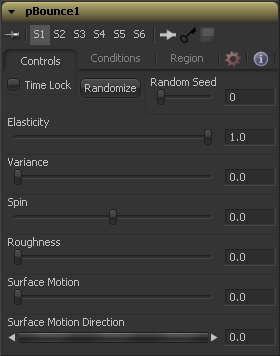Eyeon:Manual/Fusion 6/pBounce
From VFXPedia
[ Main Manual Page ]
Contents |
Controls Tab
The Seed slider and Randomize button are presented whenever a Fusion tool relies on a random result. Two tools with the same seed values will produce the same random results. Click on the Randomize button to randomly select a new seed value, or adjust the slider to manually select a new seed value.
Elasticity affects the strength of a bounce, or how much velocity the particle will have remaining after impacting upon the Bounce region. A value of 1.0 will cause the particle to possess the same velocity after the bounce as it had entering the bounce. A value of 0.1 will cause the particle to lose 90% of its velocity upon bouncing off of the region.
The range of this control is 0.0 to 1.0 by default, but greater values can be entered manually. This will cause the particles to gain momentum after an impact, rather than lose it. Negative values will be accepted, but do not produce a useful result.
By default, particles that strike the Bounce region will reflect evenly off of the edge of the Bounce region, according to the vector or angle of the region. Increasing the Variance above 0.0 will introduce a degree of variation to that angle of reflection. This can be used to simulate the effect of a rougher surface.
By default, particles that strike the region will not have their angle or orientation affected in any way. Increasing or decreasing the Spin value will cause the Bounce region to impart a spin to the particle based on the angle of collision, or to modify any existing spin on the particle. Positive values will impart a forward spin and negative values impart a backward spin. The larger the value, the faster the spin applied to the particle will be.
This slider varies the bounce off of the surface to slightly randomize particle direction.
This slider makes the bounce surface behave is if it had motion, thus affecting the particles.
This thumbwheel control sets the angle relative to the bounce surface.
Conditions and Regions Tab
Please see 'Particle Common Controls' in the Particles chapter.
Tips for pBounce (edit)
EyeonTips:Manual/Fusion 6/pBounce
| The contents of this page are copyright by eyeon Software. |

